Abstract
Lightcurves for 38 near-Earth asteroids (NEAs) obtained at the Center for Solar System Studies (CS3) from 2019 March-July were analyzed for rotation period, peak-to-peak amplitude, and signs of satellites or tumbling.
CCD photometric observations of 38 near-Earth asteroids (NEAs) were made at the Center for Solar System Studies (CS3) from 2019 March-July. Table I lists the telescopes and CCD cameras that are combined to make observations.
Table I.
List of available telescopes and CCD cameras at CS3. The exact combination for each telescope/camera pair can vary due to maintenance or specific needs.
| Telescopes | Cameras |
|---|---|
| 0.30-m f/6.3 Schmidt-Cass | FLI Microline 1001E |
| 0.35-m f/9.1 Schmidt-Cass | FLI Proline 1001E |
| 0.40-m f/10 Schmidt-Cass | SBIG STL-1001E |
| 0.40-m f/10 Schmidt-Cass | |
| 0.50-m f/8.1 Ritchey-Chrétien |
Up to nine telescopes can be used for the campaign, although seven is more common. All the cameras use CCD chips from the KAF blue-enhanced family and so have essentially the same response. The pixel scales ranged from 1.24–1.60 arcsec/pixel.
All lightcurve observations were unfiltered since a clear filter can cause a 0.1–0.3 mag loss. The exposure duration varied depending on the asteroid’s brightness and sky motion. Guiding on a field star sometimes resulted in a trailed image for the asteroid.
Measurements were made using MPO Canopus. The Comp Star Selector utility in MPO Canopus found up to five comparison stars of near solar-color for differential photometry. Comp star magnitudes were taken from ATLAS catalog (Tonry et al., 2018), which has Sloan griz magnitudes that were derived from the GAIA and Pan-STARR catalogs, among others. The authors state that systematic errors are generally no larger than 0.005 mag, although they can reach 0.02 mag in small areas near the Galactic plane. BVRI magnitudes were derived by Warner using formulae from Kostov and Bonev (2017). The overall errors for the BVRI magnitudes, when combining those in the ATLAS catalog and the conversion formulae, are on the order of 0.04–0.05.
Even so, we found in most cases that nightly zero point adjustments on the order of only 0.02–0.03 mag were required during period analysis. There were occasional exceptions that required up to 0.10 mag. These may have been related in part to using unfiltered observations, poor centroiding of the reference stars, and not correcting for second-order extinction terms. Regardless, the systematic errors seem to be considerably less than other catalogs, which reduces the uncertainty in the results when analysis involves data from extended periods or the asteroid is tumbling.
In the plots below, the “Reduced Magnitude” is Johnson V as indicated in the Y-axis title. These are values that have been converted from sky magnitudes to unity distances by applying −5*log (rΔ) to the measured sky magnitudes with r and Δ being, respectively, the Sun-asteroid and Earth-asteroid distances in AU. Unless otherwise stated, the magnitudes were normalized to the phase angle in parentheses using G = 0.15. The X-axis is the rotational phase, ranging from −0.05 to +1.05.
If the plot includes an amplitude, e.g., “Amp: 0.65”, this is the amplitude of the Fourier model curve and not necessarily the adopted amplitude for the lightcurve.
Our initial search for previous results started with the asteroid lightcurve database (LCDB; Warner et al., 2009) found on-line at http://www.minorplanet.info/lightcurvedatabase.html. Readers are strongly encouraged to obtain, when possible, the original references listed in the LCDB.
1036 Ganymed.
There are several references in the LCDB giving rotational values for this 32-km NEA. The most extensive report was by Pilcher et al. (2012), who followed the asteroid for several months and were able to make a detailed account of lightcurve synodic period and amplitude. They gave P = 10.309 h when using the entire data set. Using subsets, they found periods 10.280–10.345, making our result of 10.318 h in good agreement.

The trimodal shape is unusual but entirely possible because of the low phase angle and amplitude (Harris et al., 2014).
3103 Eger.
This 2-km NEA has been well-studied over the years. Durech et al. (2012) used sparse and dense lightcurve data to determine that the YORP (Yarkovsky–O’Keefe–Radzievskii–Paddack; Rubincam, 2000) effect was causing the asteroid’s rotation period to decrease. The uncertainty was significant; additional lightcurves extending the total range of observations will be useful for refining their result.
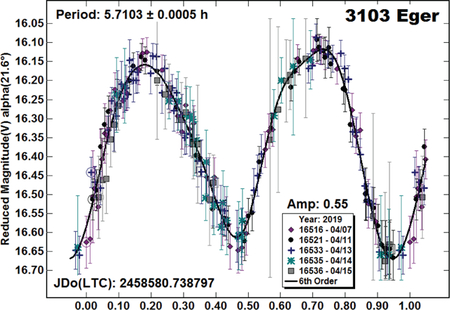
4581 Asclepius.
The period spectrum showed several nearly equal solutions from our 2019 data. The only previous results in the LCDB were from Pravec et al. (2019), who found a secure solution at 8.008 h. Our data fit to 8.006 h, but there is a significant gap in coverage. A review of solutions between 3–7 hours for a good half-period (4.805 h, “Alt 1”) made an argument for a solution near 9.6 h (“Alt 2”). We have adopted P = 8.006 h for this paper but consider it ambiguous and note that the other solutions cannot be formally excluded.
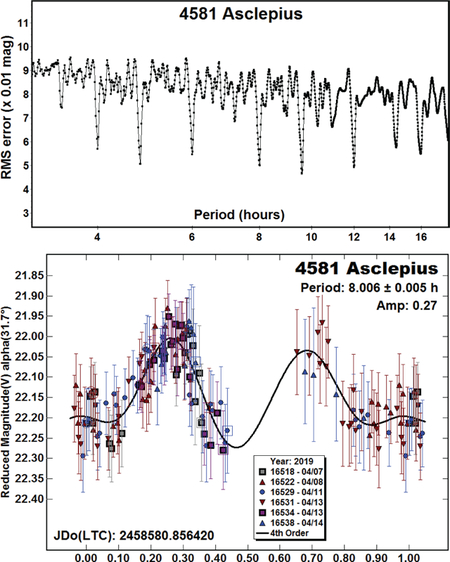
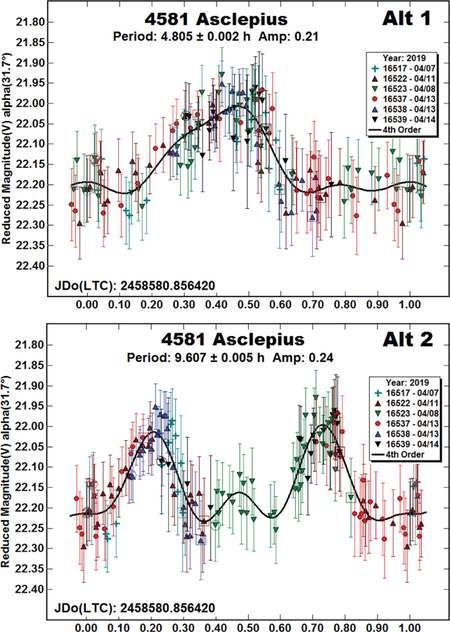
5332 Davidaguilar.
The earliest result for this 3-km NEA is from Binzel (1990; 5.82 h), who observed it when it had only the designation 1990 DA. The rotation period was subsequently refined to 5.803 h (Wisniewski et al., 1997). Other than a sidereal period derived through shape modeling (Hanus et al., 2016), those are the only previously reported periods. Our result of 5.821 h is a little longer in comparison, but that may be due in part to sidereal-synodic period differences. It’s also possible that another night or two, e.g., to get better coverage from 0.8–1.0 rotation phase, would have made our period match the others.

(5693) 1993 EA.
We observed 1993 EA in 2017 January (Warner, 2017b). At the time, a period of 2.496 h was found along with a second period of 16.55 h, which was suspected to have been due to a satellite. We observed the asteroid again in 2018 April when the phase angle bisector longitude (LPAB) was about 80° from the 2017 apparition. We found P = 2.4956 h but no traces of a second period. This is not surprising since our data were noisy and the lightcurve amplitude only 0.06 mag.

(12538) 1998 OH.
The diameter of 1998 OH is about 2 km. We worked it several times in the past. First was Warner (2015a), when an ambiguous solution of 5.833 h or 2.914 h was reported. Using data from 2016 (Warner, 2017a), a new solution of 5.154 h was found and the previous result was revised to 5.191 h. Most recently (Warner, 2019), we used data from 2018 to find a period of 2.592. Revisits to the previous data sets revised those results as well, but all new results were considered ambiguous, with a double-period still possible.

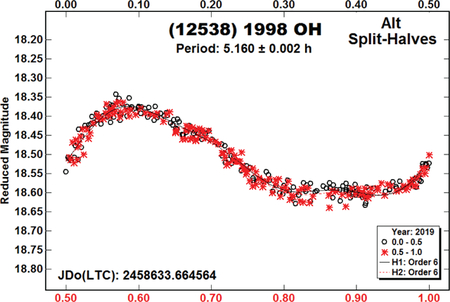
The period spectrum using the 2019 data shows the shorter period, 2.5804 h, is favored while a check of the double period using a split-halves plot shows mirrored halves, which is highly unlikely. This, along with results from Skiff et al. (2019b), leads to the conclusion that the true period is about 2.58 h and that the double solution, even though it cannot be formally excluded, can be safely rejected.
(68216) 2001 CV26.
Stephens et al. (2015) reported this to be a suspected binary asteroid, finding P1 = 2.429 h and P2 = 21.89 h. They also reported that previous radar observations did not show traces of a satellite and so the claim of being binary was considered tenuous at best.


Our data from 2019 led to P1 = 2.4292 h. The difference between the “NoSub” and “P1” plots again raised the possibility of a binary asteroid. We eventually found P2 = 15.83 h and a bimodal lightcurve that resembles a typical case of a tidally-locked, elongated satellite. The new period is not an integral multiple with the one from Stephens et al. Here again, the evidence is weak and so the true nature of the asteroid remains a mystery.
(68950) 2002 QF15.
Shepard et al. (2008) reported results from radar observations in 2003 and radar and photometric observations in 2006. The radar data indicated a size of about 2 km and a preferred rotation period of about 47 h, which was the period found from the photometric data, although the half-period (23.5 h) could not be excluded at the time.
We observed the asteroid in 2019 June. The data analysis found a period of 45.24 h, in close agreement with the preferred radar period. Despite the lack of coverage, the asymmetric shape made the half-period solution implausible, and so the longer solution is confirmed.
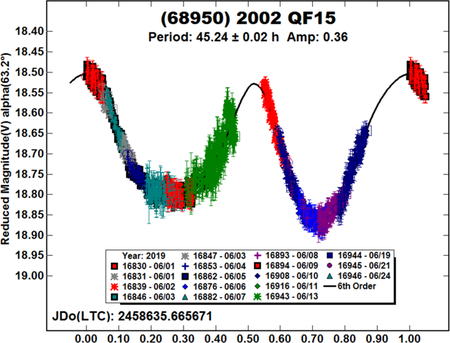
(85236) 1993 KH.
The LCDB did not list any rotation periods for 1993 KH, which has an estimated diameter of 540 meters. While the data were noisy, we’re confident that the result of P = 5.057 h is secure since the somewhat low phase angle and amplitude strongly favor a bimodal solution (Harris et al., 2014). Other factors favoring the solution are the asymmetry of the lightcurve (which ruled out the half-period solution) and that fact that some sessions covered almost a complete rotation of the presumed period.

(85989) 1999 JD6.
There are numerous results in the LCDB for this 1.1 km asteroid, e.g., Polishook and Brosch (2008, 7.6638 h), Warner (2015b, 7.673 h), and Aznar et al. (2018, 7.685 h). Our latest result is consistent with those.

(112221) 2002 KH4.
In the absence of other information, the lightcurve closely resembles one of an elongated satellite that is tidally-locked to its orbital period and shows mutual events. The estimated diameter is 2.4 km and so the size and putative orbital period are consistent with known binary asteroids. Subtracting the period from data in a dual-period search finds a nearly flat, noisy “curve” with a period of 2.479 h. This is also consistent with being a binary. This asteroid warrants detailed observations at future apparitions.
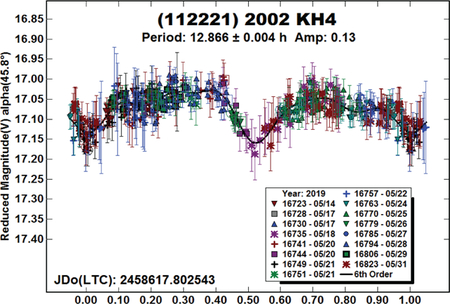
(141525) 2002 FV5.
The estimated diameter is 750 meters. There were no listings in the LCDB prior to this.
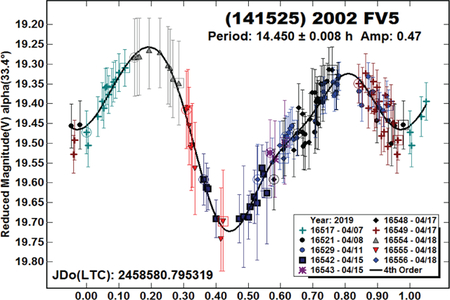
(144898) 2004 VD17.
De Luise et al. (2007) found a period of 1.99 h. The period is slightly below the “spin barrier” of P < 2.0–2.2 h, which might imply a strength-bound structure or strong cohesive forces in a “rubble pile.” Our result of 3.369 h puts the asteroid back into the league of ordinary asteroids.

(162181) 1999 LF6.
Pravec et al. (1999) found a period of 16.007 h. Warner (2014) reported 14.77 h.

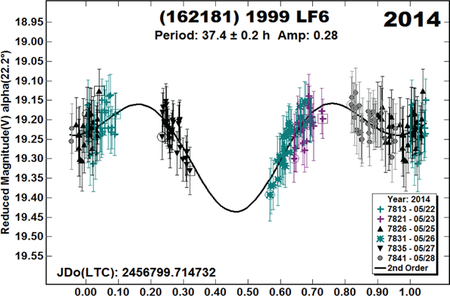
The data from our 2019 observations led to a period of 37.26 h. The noisy data do make the solution somewhat suspect but the slopes of the individual sessions are a good match to the Fourier curve. To be sure, we reviewed the 2014 data and found that a solution of 14.69 h was still slightly favored over one of 37.4 h but both showed an asymmetry of the maximums being 0.6 rotation phase apart and the longer period lightcurve with radically different minimum depths. We have adopted the 2019 result for this paper.
(163696) 2003 EB50.
Pravec et al. (2019) found a period of 62.31 h based on data obtained in 2015. Our result is in good agreement.

(244670) 2003 KN18.
The period spectrum showed numerous solutions with nearly equal RMS minimum values. After single- and dual-period analysis, we suspect that the asteroid is in a low-level state of tumbling (see Pravec et al., 2014; 2005).
MPO Canopus does not implement an algorithm suitable for analyzing tumbling asteroids, which is to solve for two periods simultaneously instead of iteratively. In some cases, however, when the two periods are similar or have a readily identified “beat period” (when the two periods repeat in an almost perfect integral ratio), MPO Canopus can be used to get a first-order solution for the two periods.
This seemed to be the case here and so we did a dual-period search that found two distinct periods of P1 = 20.887 and P2 = 37.06 h. These have a beat period of PBeat = 146.2 h, or a 7:4 ratio. When we forced a period of PBeat, two pairs of sessions were found in which the two sessions in each pair overlapped about every 6 days (144 h).

(257744) 2000 AD205.
Skiff et al. (2012; 2019a) reported on one night of observations in 2008 June to say that no period could be found.
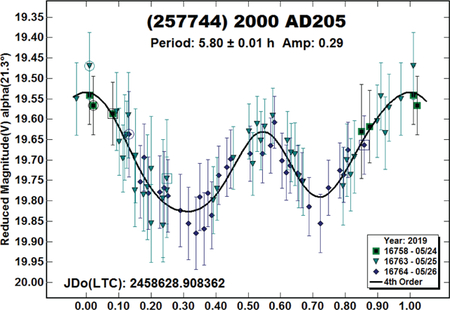
(326777) 2003 SV222.
There were no previous lightcurve results in the LCDB. The period spectrum showed some alternate solutions but the RMS for a period of 28.01 h was clearly favored.

(355256) 2007 KN4.
Waszczak et al. (2015) found a period of 7.141 h and amplitude of 0.40 mag using a “dense sparse” data set. Our result is very similar.

(453778) 2011 JK.
Skiff et al. (2019b) found a period of 2.4567 h using a very high-quality data set obtained about two weeks after ours. Our result is in good agreement.

(455736) 2005 HC3, (494999) 2010 JU39.
There were no previous entries of any kind for either of these NEAs. 2005 HC3 has an estimated diameter of 820 meters; the diameter of 2010 JU39 is about 360 m. The solution for 2010 JU39 is based on fitting a presumed half-period of 15.11 h. Neither the half- or full-period lightcurve is complete. Given the amplitude, it’s likely that P = 30.2 h is the correct solution.

2002 JW15.
Pravec et al. (2019) found a period of 11.489 h. Our period of 11.44 h is in good agreement with theirs when considering the generally lesser quality of our data.
In most cases, we assume G = 0.15 to normalize the data to the earliest session. In this case, that led to some larger than expected, or wanted, zero point shifts. We then tried G = 0.05 and G = 0.3–0.5 and found that the zero point shifts were essentially removed when using G = 0.5. When using G = 0.5, we found an absolute magnitude H = 20.92 ± 0.44. Pravec et al. used G = 0.24 to determine H = 20.60.

2006 KE.
This appears to be the first reported rotation period for this 370-meter NEA. Fortunately, the amplitude was sufficient to overcome the low SNR. Even so, the solution is not considered secure but is still very likely correct.

2008 HS3.
Using data centered on 2019 May 1, Pravec et al. (2019) reported P = 10.75 h and amplitude A = 0.17 mag. We followed the asteroid from 2019 May 12–20 to track how its lightcurve shape, period, and amplitude changed as the phase angle increased from 21° to 44° over that time.
A solution using the entire data set (“May 12–20”) is a bit confusing since the amplitude increased significantly at the end. We found a period such that the extrema lined-up to the same rotation phase as much as possible. The period we adopt for this paper is 10.67 ± 0.01 h but we note that the synodic period varied considerably when using subsets of the data and, in some cases, was ambiguous to where we report more than one period for a given subset. The most interesting solution was the trimodal lightcurve that gave the best fit for the subset May 17–20.
Needless to say, many of the solutions are far from the adopted period because of significant gaps in lightcurve coverage. Still, this made for an interesting exercise and demonstration of lightcurve evolution.

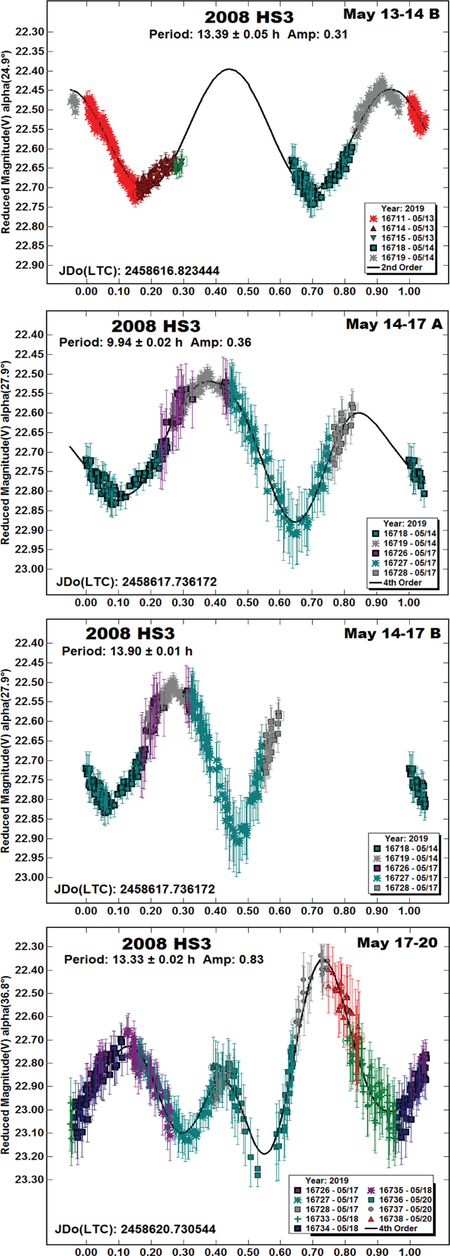
2008 WX32, 2009 DL1.
Both of these NEAs are first-time entries in the LCDB. The solution for 2008 WX32 is considered secure. Its estimated diameter is 410 meters. The solution for 2009 DL1 is less secure. Given the unusual shape and somewhat sparse coverage, we included the period spectrum to show that P = 31.83 h is the only valid result – until a denser and/or higher-quality data set comes along.
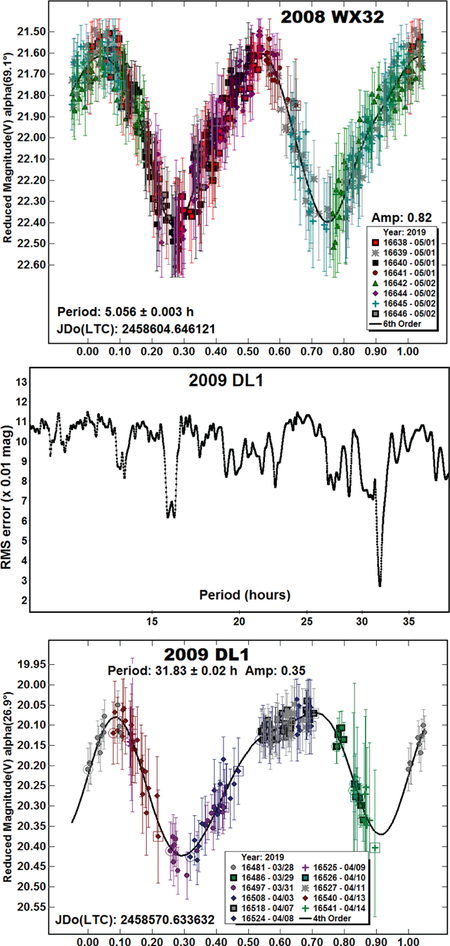
2011 HP.
Pravec et al. (2019) found a period of 3.939 h using data from 2019 April. About the same time, Skiff (2011) reported a period of 3.942 h. As we did for 2008 HS3, we followed the NEA over a wide range of phase angles (15°–51°) to demonstrate lightcurve synodic period and amplitude changes. Using the entire data set (“All”), we have adopted a period of 3.9398 ± 0.0003 h and amplitude 0.40 mag.
Most nights allowed capturing all or most of a complete rotation assuming the adopted period and so the individual lightcurves give a good sense of the changing lightcurve properties.
Data over the large range of phase angles allowed us to try finding the H and G parameters. The plot shows a very good fit to the solution of H = 21.76 ± 0.04, G = −0.121 ± 0.012. Pravec et al. found H = 21.90 ± 0.04 using an assumed G = 0.12 ± 0.08.

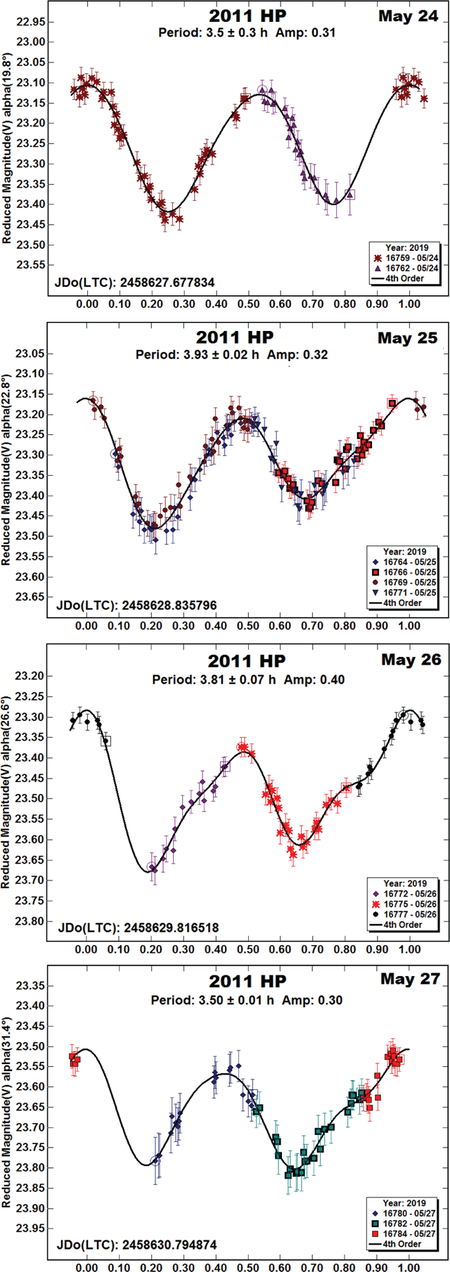

2014 LJ21, 2014 SZ303.
This appears to be the first reported rotation period for both asteroids. 2014 LJ21 has an estimated diameter of 1.8 km. The estimated diameter for 2014 SZ303 is 700 meters.

2018 EB.
Here was a case where combined radar and photometric observations helped find the most likely correct period. Radar observations clearly showed that the asteroid was binary with the satellite being a few tens of meters in size (Brozovic et al., 2019). Unfortunately the radar data could not uniquely identify the rotation period of the asteroid or the orbital period of the satellite. Photometric observations from other locations showed no significant trend in the data, i.e., a “flat” lightcurve.
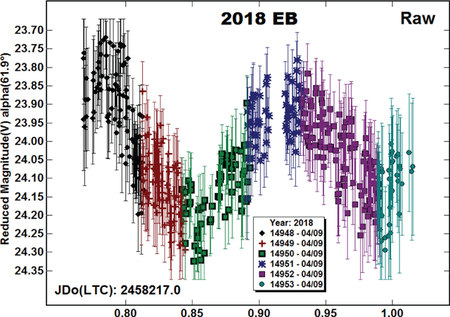
Our raw lightcurve data showed what appeared to be a bimodal lightcurve that fit to a period of 6.32 h. However, this was incompatible with the radar data. Looking at the period spectrum, a solution near 3.1 h shows a distinct RMS minimum while solutions P > 5 h “faded away” in what we call harmonic ringing. Such behavior is often seen as the Fourier analysis finds progressively longer periods that differ by a half- or full- rotation over the span of the observations.
We have adopted P = 3.16 h for this paper even though it has a monomodal shape. The amplitude is under the “limit” where a bimodal solution is almost required (Harris et al., 2014) but, more important, this period helps make sense of the radar observations.

2018 XG5, 2019 HC.
Both of these NEAs are newcomers to the LCDB listings. The estimated diameter of 2018 XG5 is 280 meters. The short period for 2019 HC, P = 1.2612 h, is somewhat unusual for an object its size, which puts it noticeably above the so-called “spin barrier.” However, it has plenty of neighbors in the frequency-diameter plot from the LCDB data.

2019 JB1, 2019 FP2.
Neither of these NEAs was in the LCDB prior to our observations. The solution for 2019 JB1 is ambiguous. We have adopted the period P = 8.30 h as being very likely. For 2019 FP, there is a Fourier curve in the lightcurve that is clearly the result of a failed attempt to fit to the noise. We offer no period or amplitude. The asteroid is included to note that data are available.
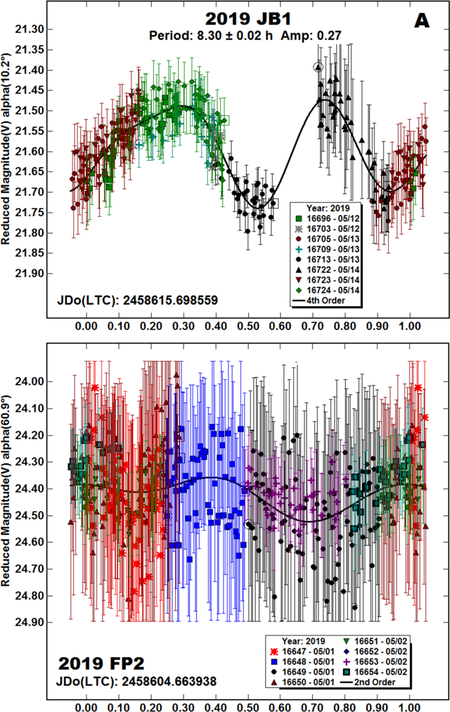
2019 KZ3.
We suspect that this 40-meter asteroid might be binary, or is in a state of non-principle axis rotation (NPAR, tumbling). At the scale presented here, it is difficult to see that a second period might be in the lightcurve plot without subtraction of a second period.

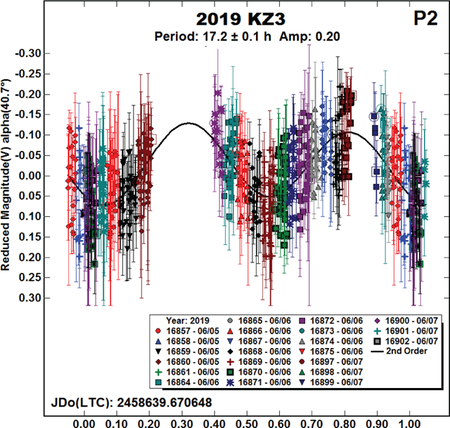
However, after close examination, we tried a dual-period search and found a clear secondary period, the low SNR data notwithstanding. As of 2019 July, the binary with the smallest primary is 2015 TD144 (D = 0.09 km; Radar Team, 2015).
2019 MB4, 2019 JX7.
These are both new entries to the LCDB. The estimated size of 2019 MB4 is only 20 meters, so its super-fast rotation period of 0.134411 h (8.06 min; 483.6 s) is not surprising. We were fortunate that the asteroid was sufficiently bright so the required short exposures due to sky motion still allowed reasonably high SNR values.
The estimated diameter of 2019 JX7 is 150 meters. At this size, it is not uncommon for an asteroid to have a rotation period P < 2 h. Our period of 14.09 h is not extraordinary for being long. In fact, it is somewhat short among the 57 objects in the LCDB (2019 July 14) with a reliable period, D < 0.2 km, and P > 10 h. The longest belongs to 2013 US3 at 450 h.


Table II.
Observing circumstances.
| Number | Name | 20xx mm/dd# | Phase | LPAB | BPAB | Period(h) | P.E. | Amp | A.E. |
|---|---|---|---|---|---|---|---|---|---|
| 1036 | Ganymed | 06/03–06/09 | 15.7,17.0 | 205 | −1 | 10.318 | 0.002 | 0.11 | 0.01 |
| 3103 | Eger | 04/07–04/15 | 21.6,20.7 | 212 | 30 | 5.7103 | 0.0005 | 0.55 | 0.03 |
| 4581 | Asclepius | 04/07–04/14 | 31.8,19.0 | 215 | 8 | 8.006 | 0.005 | 0.27 | 0.03 |
| Alternate 1 | 4.805 | 0.002 | 0.21 | 0.03 | |||||
| Alternate 2 | 9.607 | 0.005 | 0.24 | 0.03 | |||||
| 5332 | Davidaguilar | 05/01–05/02 | 15.4,15.4 | 218 | 32 | 5.821 | 0.007 | 0.62 | 0.05 |
| 5693 | 1993 EA | 04/07–04/28 | *9.0,15.1 | 204 | 8 | 2.4956 | 0.0003 | 0.06 | 0.02 |
| 12538 | 1998 OH | 05/30–06/01 | 73.3,71.2 | 207 | 28 | 2.5804 | 0.0006 | 0.22 | 0.02 |
| Alternate | 5.160 | 0.002 | 0.23 | 0.02 | |||||
| 68216 | 2001 CV26 | 03/30–04/11 | 47.5,45.5 | 151 | 15 | 2.4292 | 0.0001 | 0.24 | 0.02 |
| P2 (satellite?) | 15.83 | 0.02 | 0.13 | 0.02 | |||||
| 68950 | 2002 QF15 | 06/01–06/24 | 63.1,53.0 | 224 | 21 | 45.24 | 0.02 | 0.36 | 0.03 |
| 85236 | 1993 KH | 05/03–05/06 | 17.1,19.7 | 209 | 8 | 5.057 | 0.005 | 0.32 | 0.03 |
| 85989 | 1999 JD6 | 06/03–06/07 | 29.3,28.0 | 262 | 27 | 7.661 | 0.002 | 1.08 | 0.03 |
| 112221 | 2002 KH4 | 05/14–05/31 | 45.8,46.8 | 254 | 48 | 12.866 | 0.004 | 0.13 | 0.02 |
| 141525 | 2002 FV5 | 04/07–04/18 | *33.4,34.0 | 212 | 24 | 14.450 | 0.008 | 0.47 | 0.03 |
| 144898 | 2004 VD17 | 04/19–04/25 | 23.0,34.2 | 190 | −4 | 3.369 | 0.002 | 0.19 | 0.03 |
| 162181 | 1999 LF6 | 05/03–05/13 | *12.6,15.0 | 229 | 13 | 37.26 | 0.07 | 0.32 | 0.04 |
| Revised | 14/05/22–05/28 | 22.0,26.1 | 236 | 21 | 37.4 | 0.2 | 0.33 | 0.03 | |
| 163696 | 2003 EB50 | 05/01–05/13 | 18.9,22.0 | 217 | 22 | 62.06 | 0.03 | 1.01 | 0.03 |
| 244670 | 2003 KN18 | 05/21–05/29 | 60.2,53.0 | 212 | 30 | 20.887 | 0.007 | 1.01 | 0.05 |
| P2 (NPAR?) | 37.06 | 0.07 | 0.5 | 0.1 | |||||
| 257744 | 2000 AD205 | 05/24–05/26 | 21.4,23.0 | 238 | 18 | 5.80 | 0.01 | 0.29 | 0.03 |
| 326777 | 2003 SV222 | 05/28–06/04 | *21.8,31.2 | 228 | 6 | 28.01 | 0.05 | 0.14 | 0.01 |
| 355256 | 2007 KN4 | 06/04–06/07 | 23.0,25.6 | 235 | 7 | 7.152 | 0.003 | 0.43 | 0.02 |
| 453778 | 2011 JK | 05/14–05/20 | 77.5,73.4 | 194 | 16 | 2.4580 | 0.0004 | 0.33 | 0.03 |
| 455736 | 2005 HC3 | 06/08–06/25 | *23.1,13.2 | 263 | 14 | 14.40 | 0.02 | 0.34 | 0.04 |
| 494999 | 2010 JU39 | 06/26–06/28 | 55.2,69.1 | 247 | 19 | 30.2 | 0.1 | 0.48 | 0.05 |
| 2002 JW15 | 05/01–05/08 | 26.3,37.8 | 203 | 0 | 11.44 | 0.02 | 0.45 | 0.04 | |
| 2006 KE | 06/02–06/04 | 30.4,32.5 | 260 | 22 | 6.95 | 0.02 | 0.43 | 0.05 | |
| 2008 HS3 | 05/12–05/20 | 21.3,43.6 | 245 | 14 | 10.67 | 0.01 | 0.26–0.83 | ||
| 2008 HS3 | 05/12–05/13 | 21.3,24.7 | 240 | 9 | 10.60 | 0.04 | 0.30 | 0.02 | |
| 2008 HS3 | 05/13–05/14 | 24.7,28.0 | 242 | 11 | 8.98 | 0.05 | 0.26 | 0.02 | |
| Alternate | 13.39 | 0.05 | 0.31 | 0.03 | |||||
| 2008 HS3 | 05/14–05/17 | 28.0,36.9 | 245 | 14 | 9.94 | 0.02 | 0.36 | 0.03 | |
| Alternate | 13.90 | 0.01 | 0.36 | 0.03 | |||||
| 2008 HS3 | 05/17–05/20 | 36.9,43.6 | 248 | 19 | 13.33 | 0.02 | 0.83 | 0.05 | |
| 2008 WX32 | 05/01–05/02 | 68.9,66.8 | 199 | 39 | 5.056 | 0.003 | 0.82 | 0.05 | |
| 2009 DL1 | 03/28–04/14 | 27.0,39.1 | 169 | −2 | 31.83 | 0.02 | 0.35 | 0.03 | |
| 2011 HP | 05/21–05/30 | 14.9,51.5 | 246 | 15 | 3.9398 | 0.0003 | 0.40 | 0.05 | |
| 05/21–05/21 | 14.9 | 234 | 6 | 3.86 | 0.06 | 0.28 | 0.02 | ||
| 05/22–05/22 | 16.2 | 236 | 8 | 3.74 | 0.03 | 0.32 | 0.02 | ||
| 05/24–05/24 | 20.1 | 240 | 11 | 3.5 | 0.3 | 0.31 | 0.02 | ||
| 05/25–05/25 | 23.2 | 243 | 12 | 3.93 | 0.02 | 0.32 | 0.02 | ||
| 05/26–05/26 | 27.1 | 245 | 15 | 3.81 | 0.07 | 0.40 | 0.02 | ||
| 05/27–05/27 | 32.0 | 249 | 17 | 3.50 | 0.01 | 0.30 | 0.02 | ||
| 05/28–05/28 | 37.8 | 252 | 19 | 3.95 | 0.02 | 0.40 | 0.03 | ||
| 05/29–05/29 | 44.4 | 257 | 22 | 3.87 | 0.01 | 0.46 | 0.03 | ||
| 05/30–05/30 | 51.5 | 262 | 24 | 4.06 | 0.02 | 0.54 | 0.03 | ||
| 2014 LJ21 | 05/03–05/08 | 53.2,48.8 | 171 | 36 | 16.41 | 0.03 | 0.19 | 0.03 | |
| 2014 SZ303 | 06/26–07/02 | 53.1,40.8 | 251 | 19 | 5.8559 | 0.0007 | 0.31 | 0.02 | |
| 2018 EB | 18/04/08–04/09 | 55.9,62.9 | 197 | 31 | 3.16 | 0.01 | 0.26 | 0.05 | |
| Alternate | 6.32 | 0.02 | 0.28 | 0.05 | |||||
| 2018 XG5 | 05/08–05/13 | 51.6,41.1 | 209 | 17 | 2.6594 | 0.0003 | 0.26 | 0.02 | |
| 2019 HC | 04/26–04/27 | 20.4,21.3 | 227 | 9 | 1.2624 | 0.0003 | 0.09 | 0.01 | |
| 2019 JB1 | 05/12–05/14 | 10.1,11.8 | 229 | 5 | 8.30 | 0.02 | 0.27 | 0.03 | |
| 2019 FP2 | 05/01–05/02 | 60.8,60.4 | 199 | 26 | − | − | − | − | |
| 2019 KZ3 | 06/05–06/08 | *39.8,36.0 | 261 | 13 | 0.393684 | 0.000007 | 1.40 | 0.05 | |
| P2 (satellite?) | 17.2 | 0.1 | 0.20 | 0.04 | |||||
| 2019 MB4 | 07/08–07/09 | 82.7,72.4 | 271 | 30 | 0.134411 | 0.000004 | 0.55 | 0.05 | |
| 2019 JX7 | 05/31–06/02 | 23.7,26.8 | 237 | 8 | 14.09 | 0.02 | 0.60 | 0.03 |
All dates are in 2019 unless the first date includes a two-digit year. The phase angle (α) is given at the start and end of each date range. If there is an asterisk before the first phase value, the phase angle reached a maximum or minimum during the period. LPAB and BPAB are, respectively the average phase angle bisector longitude and latitude (see Harris et al.,1984). Some asteroids have more than one line. If the additional lines have “Alternate”, the result is ambiguous. The line in bold text is the period adopted for this work and the additional lines give the alternate solutions. If “P2” is the second line, it is a secondary period that is due to a confirmed or suspected satellite. “NPAR” indicates that the line has the second period of a tumbling asteroid. “Revised” indicates a new period using a previous data set that is based on the period adopted in this work. See the text for additional details
Acknowledgements
Funding for observations at CS3 and work on the asteroid lightcurve database (Warner et al., 2009) and ALCDEF database (alcdef.org) are supported by NASA grant 80NSSC18K0851.
The authors gratefully acknowledge Shoemaker NEO Grants from the Planetary Society (2007, 2013). These were used to purchase some of the telescopes and CCD cameras used in this research.
This work includes data from the Asteroid Terrestrial-impact Last Alert System (ATLAS) project. ATLAS is primarily funded to search for near earth asteroids through NASA grants NN12AR55G, 80NSSC18K0284, and 80NSSC18K1575; byproducts of the NEO search include images and catalogs from the survey area. The ATLAS science products have been made possible through the contributions of the University of Hawaii Institute for Astronomy, the Queen’s University Belfast, the Space Telescope Science Institute, and the South African Astronomical Observatory.
Contributor Information
Brian D. Warner, Center for Solar System Studies / MoreData!, 446 Sycamore Ave. Eaton, CO 80615 USA
Robert D. Stephens, Center for Solar System Studies / MoreData!, Rancho Cucamonga, CA 91730
References
References from web sites should be considered transitory, unless from an agency with a long lifetime expectancy. Sites run by private individuals, even if on an institutional web site, do not necessarily fall into this category.
- Aznar Macias A; Predatu M; Vaduvescu O; Oey J (2018). “EURONEAR - First Light Curves and Physical Properties of Near Earth Asteroids.” arXiv:1801.09420. [Google Scholar]
- Binzel RP (1990). “1990 DA.” IAUC 4969. [Google Scholar]
- Brozovic M; Benner LAM; Naidu SP; Hughes RS; Giorgini JD; Warner BD; Virkki AK; Marshall SE; Tayloer PA; Rivera-Valentin EG; Lister TA; Chatelain JP; Pollock JT; Busch MW (2019). “Radar and Lightcurve Observations of Binary Near-Earth Asteroid 2019 EB.” Binary Asteroids 5 Workshop, Fort Collins, CO. 2019 Sep 3–5. [Google Scholar]
- De Luise F; Perna D; Dotto E; Fornasier S; Belskaya IN; Boattini A; Valsecchi GB; Milani A; Rossi A; Lazzarin M; Paolicchi P; Gulchignoni M” (2007). “Physical investigation of the potentially hazardous Asteroid (144898) 2004 VD17.” Icarus 191, 628–635. [Google Scholar]
- Durech J; Vokrouhlicky D; Baransky AR; Breiter S; Burkhonov OA; Cooney W; Fuller V; Gaftonyuk NM; Gross J; Inasaridze R.Ya.; and 21 others (2012). “Analysis of the rotation period of asteroids (1865) Cerberus, (2100) Ra-Shalom, and (3103) Eger - search for the YORP effect.” Astron. Astrophys 547, A10. [Google Scholar]
- Hanus J; Durech J; Oszkiewicz DA; Behrend R; Carry B; Delbo M; Adam O; Afonina V; Anquetin R; Antonini P; and 159 coauthors. (2016). “New and updated convex shape models of asteroids based on optical data from a large collaboration network.” Astron. Astrophys 586, A108. [Google Scholar]
- Harris AW; Young JW; Scaltriti F; Zappala V (1984). “Lightcurves and phase relations of the asteroids 82 Alkmene and 444 Gyptis.” Icarus 57, 251–258. [Google Scholar]
- Harris AW; Young JW; Bowell E; Martin LJ; Millis RL; Poutanen M; Scaltriti F; Zappala V; Schober HJ; Debehogne H; Zeigler KW (1989). “Photoelectric Observations of Asteroids 3, 24, 60, 261, and 863.” Icarus 77, 171–186. [Google Scholar]
- Harris AW; Pravec P; Galad A; Skiff BA; Warner BD; Vilagi J; Gajdos S; Carbognani A; Hornoch K; Kusnirak P; Cooney WR; Gross J; Terrell D; Higgins D; Bowell E; Koehn BW (2014). “On the maximum amplitude of harmonics on an asteroid lightcurve.” Icarus 235, 55–59. [Google Scholar]
- Kostov A; Bonev T (2017). “Transformation of Pan-STARRS1 gri to Stetson BVRI magnitudes. Photometry of small bodies observations.” Bulgarian Astron. J 28, 3 (AriXiv:1706.06147v2). [Google Scholar]
- Pilcher F; Benishek V; Briggs JW; Ferrero A; Klinglesmith DA III; Warren CA (2012). “Eight Months of Lightcurves of 1036 Ganymed.” Minor Planet Bull. 39, 141–144. [Google Scholar]
- Polishook D; Brosch N (2008). “Photometry of Aten asteroids—More than a handful of binaries.” Icarus 194, 111–124. [Google Scholar]
- Pravec P; Wolf M; Sarounova L (1999, 2019) http://www.asu.cas.cz/~ppravec/neo.htm
- Pravec P; Harris AW; Scheirich P; Kušnirák P; Šarounová L; Hergenrother CW; Mottola S; Hicks MD; Masi G; Krugly Yu.N.; Shevchenko VG; Nolan MC; Howell ES; Kaasalainen M; Galád A; Brown P; Degraff DR; Lambert JV; Cooney WR; Foglia S (2005). “Tumbling asteroids.” Icarus 173, 108–131. [Google Scholar]
- Pravec P; Scheirich P; Durech J; Pollock J; Kusnirak P; Hornoch K; Galad A; Vokrouhlicky D; Harris AW; Jehin E; Manfroid J; Opitom C; Gillon M; Colas F; Oey J; Vrastil J; Reichart D; Ivarsen K; Haislip J; LaCluyze A (2014). “The tumbling state of (99942) Apophis.” Icarus 233, 48–60. [Google Scholar]
- Radar Team (2015). Observers at Arecibo and/or Goldstone. http://www.naic.edu/~pradar/ http://www.jpl.nasa.gov/asteroidwatch
- Rubincam DP (2000). “Relative Spin-up and Spin-down of Small Asteroids.” Icarus 148, 2–11. [Google Scholar]
- Shepard MK; Benner LAM; Ostro SJ; Nolan MC; Giorgini JD; Magri C; Warner BD (2008). “Radar Observations of Potentially Hazardous Asteroid 68950 (2002 QF15).” Asteroids, Comets, Meteors 2008, Baltimore, MD.; id.8029. [Google Scholar]
- Skiff BA (2011). Posting on CALL web site. http://www.minorplanet.info/call.html
- Skiff BA; Bowell E; Koehn BW; Sanborn JJ; McLelland KP; Warner BD (2012). “Lowell Observatory Near-Earth Asteroid Photometric Survey (NEAPS) - 2008 May through 2008 December.” Minor Planet Bull. 39, 111–130. [Google Scholar]
- Skiff BA; McLelland KP; Sanborn JJ; Pravec P; Koehn BW (2019a). “Lowell Observatory Near-Earth Asteroid Photometric Survey (NEAPS): Paper 3.” Minor Plantet Bull. 46, 238–265. [Google Scholar]
- Skiff BA; McLelland KP; Sanborn J; Pravec P; Koehn BW (2019b). “Lowell Observatory Near-Earth Asteroid Photometric Survey (NEAPS): Paper 3.” Minor Planet Bull. 46, THIS ISSUE. [Google Scholar]
- Stephens RD; French LM; Warner BD; Connour K (2015). “Lightcurve Analysis of Two Near-Earth Asteroids.” Minor Planet Bull. 42, 276–277. [Google Scholar]
- Tonry JL; Denneau L; Flewelling H; Heinze AN; Onken CA; Smartt SJ; Stalder B; Weiland HJ; Wolf C (2018). “The ATLAS All-Sky Stellar Reference Catalog.” Astrophys. J 867, A105. [Google Scholar]
- Warner BD; Harris AW; Pravec P (2009). “The Asteroid Lightcurve Database.” Icarus 202, 134–146. Updated 2019 July. http://www.minorplanet.info/lightcurvedatabase.html [Google Scholar]
- Warner Brian D. (2014). “Near-Earth Asteroid Lightcurve Analysis at CS3-Palmer Divide Station: 2014 March-June.” Minor Planet Bull. 41, 213–224. [PMC free article] [PubMed] [Google Scholar]
- Warner BD (2015a). “Near-Earth Asteroid Lightcurve Analysis at CS3-Palmer Divide Station: 2014 October-December.” Minor Planet Bull. 42, 115–127. [PMC free article] [PubMed] [Google Scholar]
- Warner BD (2015b). “Near-Earth Asteroid Lightcurve Analysis at CS3-Palmer Divide Station: 2015 March-June.” Minor Planet Bull. 42, 256–266. [PMC free article] [PubMed] [Google Scholar]
- Warner BD (2017a). “Near-Earth Asteroid Lightcurve Analysis at CS3-Palmer Divide Station: 2016 October-December.” Minor Planet Bull. 44, 98–107. [PMC free article] [PubMed] [Google Scholar]
- Warner BD (2017b). “Near-Earth Asteroid Lightcurve Analysis at CS3-Palmer Divide Station: 2016 December thru 2017 April.” Minor Planet Bull. 44, 223–237. [PMC free article] [PubMed] [Google Scholar]
- Warner BD (2019). “(12538) 1998 OH: A Continuing Non-resolution.” Minor Planet Bull. 46, 157–160. [PMC free article] [PubMed] [Google Scholar]
- Wisniewski WZ; Michalowski TM; Harris AW; McMillan RS (1997). “Photometric Observations of 125 Asteroids.” Icarus 126, 395–449. [Google Scholar]


